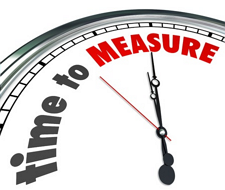 The killer feature of email marketing is the metrics. However, just looking at open rates and click rates each month, noting they’ve gone up or down but not using the data to learn and change means you’re missing out.
The killer feature of email marketing is the metrics. However, just looking at open rates and click rates each month, noting they’ve gone up or down but not using the data to learn and change means you’re missing out.
So what should you do instead? I’ve asked 9 email marketing experts to share how you can get more value from your email metrics, what metrics matter, what you should track and use to drive improvement in your email marketing performance.
 Dave Chaffey, SmartInsights, CEO and Author
Dave Chaffey, SmartInsights, CEO and Author
Email marketers tend to use open and clicks to compare campaigns because that’s the main measures that are available. But of course what matters is the £$€ generated after the click, so I recommend comparing campaigns by revenue per 1000 emails sent. It’s easier for retailers or other Ecommerce sites to do this, but any business who has their Google Analytics setup to record Goal Value should do this. Using Google Analytics campaign tracking for email will enable you to compare campaigns by value generated in Google Analytics.
Other than that, the main way I look to improve emails is through heat maps or link click rates to see which CTAs are working best – usually the Hero’s of course.
 Jordie van Rijn, Emailvendorselection.com founder & EmailMonday, Email Marketing Consultant.
Jordie van Rijn, Emailvendorselection.com founder & EmailMonday, Email Marketing Consultant.
Looking at engagement over time can be very insightful and you might realise that certain types of emails work better to convert and activate people that haven’t opened –clicked in a while. An additional click from an already crazily engaged subscriber could be of less value to you – especially if they are “just a fan”, not a potential client. Even more insights can come from looking at the last purchase date and average NET order value and split your reports based on those.
A study by GetResponse on responsive email design showed that 42% of subscribers intend to delete emails that don’t display correctly on their smartphones. Now you want to take that with a grain of salt, if optimizing for mobile, look at the engagement split per device. The trick however is to check if the subscriber switches devices to complete their orders, possibly skipping the email and going directly to the site. Missing those mobile to web switchers can muddy the water, especially if you are trying to optimize the mobile part of it.
 Chad White – Lead Research Analyst, Salesforce Marketing Cloud
Chad White – Lead Research Analyst, Salesforce Marketing Cloud
When it comes to improving performance, the conversion rate is the most underused metric. Whether you’re looking at the performance of subject lines, email content, or landing pages, you should always be looking as far down the funnel as possible because all the elements of an email should be building toward that singular goal.
For instance, sometimes marketers think if they can just get subscribers to open their email—it doesn’t matter how—then they are more likely to convert because then they’re read the email copy. When looking at a single campaign that might be true, but if you tease, trick, or mislead subscribers into opening emails that aren’t relevant to them, then fairly quickly they will tune you out, regardless of how enticing your subject lines are. So a good subject line is actually one that preselects openers that are most likely to convert.
Unfortunately, most brands are not able to use conversion rates strategically like this because they do not feed conversion data back into their email service providers. This forces them to rely on inferior—and even misleading—metrics like opens and clicks.
 Justine Jordan – Litmus, Marketing Director
Justine Jordan – Litmus, Marketing Director
In addition to the usual suspects (open and click rates, unsubscribes, bounces and complaints), we try to develop a holistic viewpoint of email performance to determine how our messages are impacting the rest of the business. It’s not unusual for each type of email we send to have a different purpose or goal, and we try to establish those goals upfront for ease in reporting. For example, we like to see our monthly newsletters driving more traffic to our blog, so we’ll tag all newsletter links using Google Analytics UTM terms. For reporting, we’ll filter Google Analytics to look for the pageviews associated with those campaign and source terms.
For webinars, we’re looking at registrations. We’ll compare the click rate for the invitation email using the standard reports in our ESP, and then compare that to the number of registrations in GoToWebinar.
It gets a bit more complex for onboarding programs. When someone signs up for a free trial of Litmus, they receive a series of emails with the goal of increasing their engagement and converting them to a paying customer. For these emails we use the more sophisticated reports in KISSmetrics to look at churn, engagement, number of tests run, and that type of thing. It’s very encouraging to see email positively impacting engagement in our app and helping customers get more value from Litmus.
 Kath Pay – Marketing Director
Kath Pay – Marketing Director
I always use the metric which maps back to the objective. For example if your objective is to generate sales and revenue, then conversion to sale needs to be the metric that you would use to aid improvement. That doesn’t mean that you completely ignore metrics such as opens and clicks – these should be included within your monitoring and reports, but you don’t make major decisions based upon these metrics.
An example I’ve used for years is the following acquisition campaign that was run by Veet. They were renting a list and wanted to make the most of their acquisition budget and so tested 4 different subject lines.

You can see that although the first line tested gained the most opens, it resulted in the least conversions, whereas the last subject line gained the least opens yet the highest conversions.
 Becs Rivett – Yorkshire Building Society, Email Marketing Specialist
Becs Rivett – Yorkshire Building Society, Email Marketing Specialist
This past year I have been focusing on the undelivered emails because I see it as an area where we have been failing. Working in financial services, there is some information that must be delivered to customers to ensure that as a company, we are compliant with regulations. So I have been working hard to ensure that the quality of our lists is maintained, and where possible, improved.
The number of valid email addresses we hold across the businesses has gone down which obviously impacts our ability to reduce costs by marketing via email, even though email is our most successful channel as a % of take up of products.
Having a better quality list will help improve inbox delivery over time and also ensures we have a decent amount of people that we can marketing to. It’s useful to encourage users to review their contact details occasionally to ensure that they are up to date. Incorrect information costs money as well as reputation.
 Andrew Bonar, Deliverability Ltd, Managing Director & EmailExpert.org, Founder
Andrew Bonar, Deliverability Ltd, Managing Director & EmailExpert.org, Founder
It’s incredibly difficult to address the question “what is the single most important metric is for measuring the success of an email campaign”. No single metric taken in isolation is going to give you the full view of the ROI and benefit-cost analysis required to measure your success.
If asked “what is the single most important metric is for measuring the deliverability success of an email campaign” the question is easier to answer. Better than any inbox placement report, seed testing report or even panel based data is per-domain based open metrics. If your average open rates are sitting at 17%, and most domains are showing 15-20% open rates, but one or two show an open rate markedly different, it is likely you are experiencing deliverability problems at that domain.
If asked “what is the single most important metric is for measuring the relevance and value to my subscribers of an email campaign” I would be looking at attrition rates as a result of spam complaints and unsubscribes and balance this with open-to-click and conversion rates.
Take a daily deals business, the most important metric is email revenue. However even this needs to be balanced with other factors such as your complaints and unsubscribes if you want to get a true cost-benefit analysis. To give an example (a rather extreme one, but serves the purpose of illustrating my point). Say you are able to generate an additional $23,000 in sales by using a deceptive subject line, but a side effect is a 5% unsubscribe/complaint rate on a list of 200,000. Taking the average subscriber lifetime value at £20, then the revenue gain of £23K cost £200K in lost subscribers. Add to this the invisible cost of reduced inbox placement as a result of complaints.
So the most useful metric in email really depends on what it is you are trying to achieve with your email program and what you are in a position to measure.
 Samantha Iodice, Email Strategist
Samantha Iodice, Email Strategist
My answer varies depending on what data is available; however, regarding metrics that anyone can use, CTOR /Click To Open Rate is quite powerful. Also called the Effective Rate, it is the best measurement of performance of the overall email test when sales attribution data is unavailable, as so often it is.
An example would be a test between 2 email creatives. The same Subject Line, Layout and Graphic elements are used; however, the copy content is different. Here’s what those metrics may look like:

Delivered and opens are close, but CTR sees different action, demonstrating the content is more engaging in the Test versus the Control. Then, what the CTOR provides is a clear percentage of how much more effective the messaging performed over the control. Any upper management can understand these numbers as well as their implications.
Dela Quist – Alchemy Worx, CEO
With the possible exception of revenue per customer I do not value any KPI that tracks or targets rates such as open rate, click rate, conversation rate, even revenue per email. I always advise clients to measure and target totals. Total opens, total clicks total revenue, total unsubscribes etc.
My sincere thanks go to the experts for sharing their experience. Which advice resonated with you the most? Which metrics do you find most useful?

